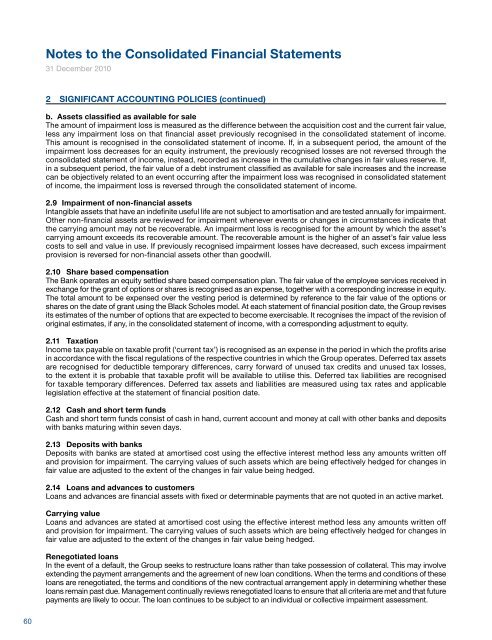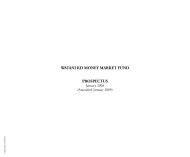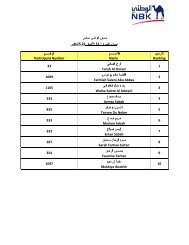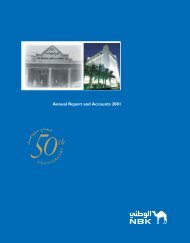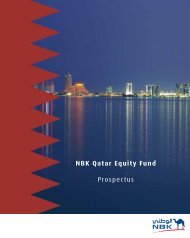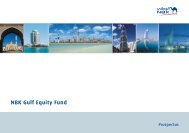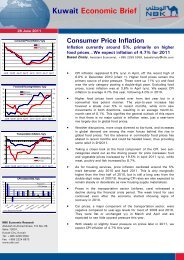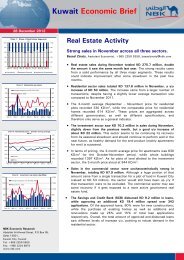Consolidated Financial Statements and Independent Auditors' Report
Consolidated Financial Statements and Independent Auditors' Report
Consolidated Financial Statements and Independent Auditors' Report
You also want an ePaper? Increase the reach of your titles
YUMPU automatically turns print PDFs into web optimized ePapers that Google loves.
Notes to the <strong>Consolidated</strong> <strong>Financial</strong> <strong>Statements</strong><br />
31 December 2010<br />
2 SIGNIFICANT ACCOUNTING POLICIES (continued)<br />
b. Assets classified as available for sale<br />
The amount of impairment loss is measured as the difference between the acquisition cost <strong>and</strong> the current fair value,<br />
less any impairment loss on that financial asset previously recognised in the consolidated statement of income.<br />
This amount is recognised in the consolidated statement of income. If, in a subsequent period, the amount of the<br />
impairment loss decreases for an equity instrument, the previously recognised losses are not reversed through the<br />
consolidated statement of income, instead, recorded as increase in the cumulative changes in fair values reserve. If,<br />
in a subsequent period, the fair value of a debt instrument classified as available for sale increases <strong>and</strong> the increase<br />
can be objectively related to an event occurring after the impairment loss was recognised in consolidated statement<br />
of income, the impairment loss is reversed through the consolidated statement of income.<br />
2.9 Impairment of non-financial assets<br />
Intangible assets that have an indefinite useful life are not subject to amortisation <strong>and</strong> are tested annually for impairment.<br />
Other non-financial assets are reviewed for impairment whenever events or changes in circumstances indicate that<br />
the carrying amount may not be recoverable. An impairment loss is recognised for the amount by which the asset’s<br />
carrying amount exceeds its recoverable amount. The recoverable amount is the higher of an asset’s fair value less<br />
costs to sell <strong>and</strong> value in use. If previously recognised impairment losses have decreased, such excess impairment<br />
provision is reversed for non-financial assets other than goodwill.<br />
2.10 Share based compensation<br />
The Bank operates an equity settled share based compensation plan. The fair value of the employee services received in<br />
exchange for the grant of options or shares is recognised as an expense, together with a corresponding increase in equity.<br />
The total amount to be expensed over the vesting period is determined by reference to the fair value of the options or<br />
shares on the date of grant using the Black Scholes model. At each statement of financial position date, the Group revises<br />
its estimates of the number of options that are expected to become exercisable. It recognises the impact of the revision of<br />
original estimates, if any, in the consolidated statement of income, with a corresponding adjustment to equity.<br />
2.11 Taxation<br />
Income tax payable on taxable profit (‘current tax’) is recognised as an expense in the period in which the profits arise<br />
in accordance with the fiscal regulations of the respective countries in which the Group operates. Deferred tax assets<br />
are recognised for deductible temporary differences, carry forward of unused tax credits <strong>and</strong> unused tax losses,<br />
to the extent it is probable that taxable profit will be available to utilise this. Deferred tax liabilities are recognised<br />
for taxable temporary differences. Deferred tax assets <strong>and</strong> liabilities are measured using tax rates <strong>and</strong> applicable<br />
legislation effective at the statement of financial position date.<br />
2.12 Cash <strong>and</strong> short term funds<br />
Cash <strong>and</strong> short term funds consist of cash in h<strong>and</strong>, current account <strong>and</strong> money at call with other banks <strong>and</strong> deposits<br />
with banks maturing within seven days.<br />
2.13 Deposits with banks<br />
Deposits with banks are stated at amortised cost using the effective interest method less any amounts written off<br />
<strong>and</strong> provision for impairment. The carrying values of such assets which are being effectively hedged for changes in<br />
fair value are adjusted to the extent of the changes in fair value being hedged.<br />
2.14 Loans <strong>and</strong> advances to customers<br />
Loans <strong>and</strong> advances are financial assets with fixed or determinable payments that are not quoted in an active market.<br />
Carrying value<br />
Loans <strong>and</strong> advances are stated at amortised cost using the effective interest method less any amounts written off<br />
<strong>and</strong> provision for impairment. The carrying values of such assets which are being effectively hedged for changes in<br />
fair value are adjusted to the extent of the changes in fair value being hedged.<br />
Renegotiated loans<br />
In the event of a default, the Group seeks to restructure loans rather than take possession of collateral. This may involve<br />
extending the payment arrangements <strong>and</strong> the agreement of new loan conditions. When the terms <strong>and</strong> conditions of these<br />
loans are renegotiated, the terms <strong>and</strong> conditions of the new contractual arrangement apply in determining whether these<br />
loans remain past due. Management continually reviews renegotiated loans to ensure that all criteria are met <strong>and</strong> that future<br />
payments are likely to occur. The loan continues to be subject to an individual or collective impairment assessment.<br />
2.15 <strong>Financial</strong> Investments<br />
The Group classifies its financial investments in the following categories:<br />
• Held to maturity<br />
• Available for sale<br />
• Investments carried at fair value through statement of income<br />
All investments with the exception of investments at fair value through statement of income are initially recognised at<br />
cost, being the fair value of the consideration given including directly attributable transaction costs. Premiums <strong>and</strong><br />
discounts on non-trading investments (excluding those carried at fair value through statement of income) are amortised<br />
using the effective yield method <strong>and</strong> taken to interest income.<br />
Held to maturity<br />
Held to maturity investments are investments with fixed or determinable payments <strong>and</strong> fixed maturity that the Group has<br />
the intention <strong>and</strong> ability to hold to maturity. Held to maturity investments are measured at amortised cost, less provision for<br />
impairment in value if any. The losses arising from impairment of such investments are recognised in the consolidated statement<br />
of income. The interest income from debt securities classified as held to maturity is recorded in interest income.<br />
Available for sale<br />
Available for sale investments are those investments which are designated as available for sale or investments that<br />
do not qualify to be classified as fair value through statement of income, held to maturity, or loans <strong>and</strong> advances.<br />
After initial recognition, investments which are classified as “available for sale” are normally remeasured at fair value,<br />
unless fair value cannot be reliably determined in which case they are measured at cost less impairment. Fair value<br />
changes which are not part of an effective hedging relationship are reported as a separate component of equity until<br />
the investment is derecognised or the investment is determined to be impaired. On derecognition or impairment the<br />
cumulative gain or loss previously reported as “cumulative changes in fair values” within equity, is included in the<br />
consolidated statement of income for the period. In case of a reversal of previously recognised impairment losses for<br />
equity investments, such changes will not be recognised in the current consolidated statement of income but will be<br />
recorded as an increase in the reserve for cumulative changes in fair values. If, in a subsequent period, the fair value<br />
of a debt instrument classified as available for sale increases <strong>and</strong> the increase can be objectively related to an event<br />
occurring after the impairment loss was recognised, the impairment loss is reversed through consolidated statement<br />
of income. The portion of any fair value changes relating to an effective hedging relationship is recognised directly<br />
in the consolidated statement of income. The interest income from debt securities classified as available for sale is<br />
recorded in interest income <strong>and</strong> the dividend income from equities are recorded in dividend income.<br />
Investments carried at fair value through statement of income<br />
Investments are classified as “investments carried at fair value through statement of income” if they are held for trading<br />
or upon initial recognition, are designated as fair value through statement of income. Investments are classified as<br />
held for trading when they are acquired for the purpose of selling or repurchase in the near term with the intention of<br />
generating short-term profits, or are derivatives which are not designated as part of effective hedges. Investments<br />
are designated as fair value through statement of income if the fair value of the investment can be reliably measured<br />
<strong>and</strong> the classification as fair value through consolidated statement of income is as per the documented strategy of<br />
the Group. Investments classified as “investments carried at fair value through statement of income” are remeasured<br />
at fair value with all changes in fair value being recorded in the statement of income. Any dividend income of equities<br />
classified as ‘investments carried at fair value through the statement of income’ are recorded as part of ‘dividend<br />
income’ <strong>and</strong> the fair value changes are recorded as part of ‘net gains / (losses) from investment securities’ in the<br />
consolidated statement of income.<br />
2.16 Fair values<br />
For investments <strong>and</strong> derivatives quoted in an active market, fair value is determined by reference to quoted market<br />
prices. Bid prices are used for assets <strong>and</strong> offer prices are used for liabilities. The fair value of investments in mutual<br />
funds, unit trusts, or similar investment vehicles are based on the last published bid price.<br />
For financial instruments where there is no active market, fair value is normally based on one of the following:<br />
• the expected cash flows discounted at current rates applicable for items with similar terms <strong>and</strong> risk characteristics<br />
• brokers’ quotes<br />
• recent transactions<br />
• option pricing models<br />
The estimated fair value of deposits with no stated maturity, including non-interest bearing deposits, is the amount<br />
payable on dem<strong>and</strong>.<br />
60 National Bank of Kuwait - Annual <strong>Report</strong> 2010 61


